75 years ago, Soviet troops stormed Budapest
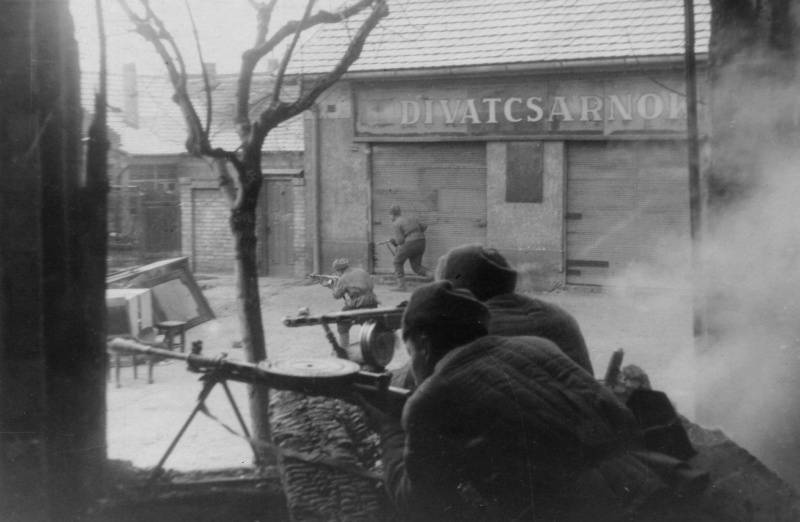
Submachine gunners of the 3rd Ukrainian Front in street battles for Budapest. January 1945
The Agony of the Third Reich. 75 years ago, on February 13, 1945, Soviet troops completed the assault on the capital of Hungary, the city of Budapest. The successful completion of the Budapest operation dramatically changed the entire strategic situation on the southern wing of the Soviet-German front and facilitated the advance of the Red Army in the Berlin direction.
The Hungarian capital, troops of the 2nd Ukrainian Front under the command of Marshal R. Ya. Malinovsky and the 3rd Ukrainian Front, Marshal F.I. Tolbukhin was blocked on December 26, 1944. Surrounded by 188 thousand German-Hungarian group proposed to fold weapon. However, the Nazis killed the Soviet parliamentarians. Of all the European capitals taken by Soviet troops, Budapest took first place in the duration of street battles.
Firstly, this was due to the difficult operational situation on the outer ring of the encirclement, where the Nazis repeatedly tried to free the encircled garrison of General Pfeffer-Wildenbruch. The Germans inflicted strong counterattacks with strong mobile formations. This made it difficult to concentrate on the defeat of the city's garrison. Secondly, the Soviet command, in order to save the Hungarian capital, where there were many historical monuments, and to avoid serious destruction in a crowded city, tried to avoid the use of heavy artillery and aviation. All this dragged on the capture of Budapest.
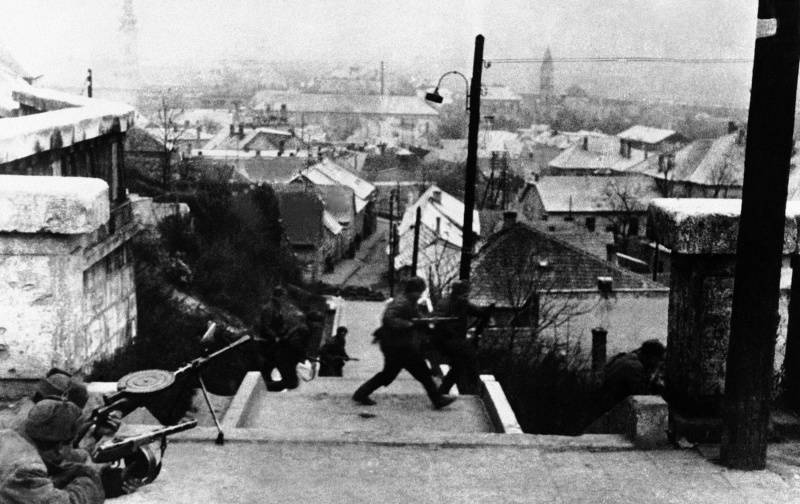
Troops of the 3rd Ukrainian Front in the battles for Budapest. January 1945
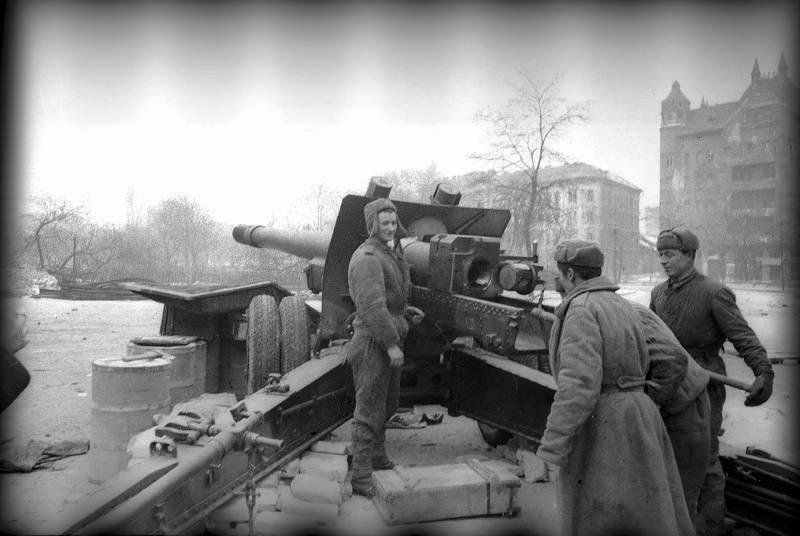
Soviet gunners are preparing to open fire from the 152-mm howitzer ML-20 in Budapest, on Calvary Square. January 1945
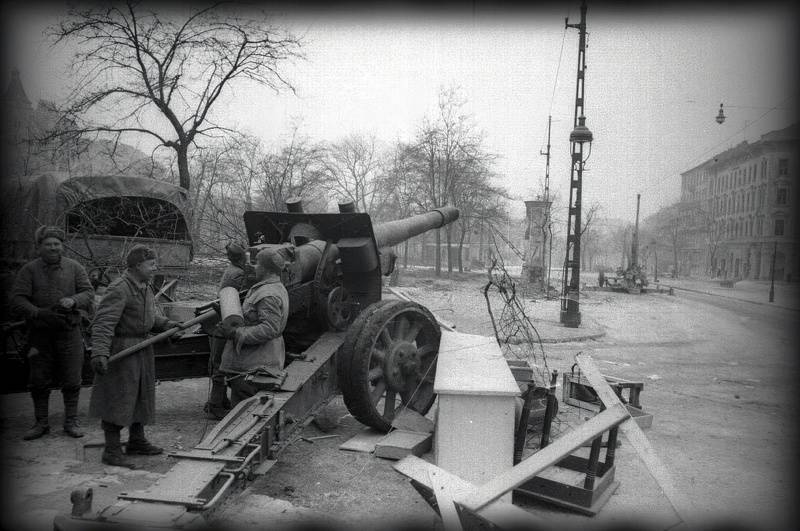
Soviet gunners are preparing to open fire from the 152-mm howitzer ML-20 on Kalwaria Square in Budapest. January - February 1945
The situation in Hungary
In the fall of 1944, the Red Army, having completed the liberation of Romania and Bulgaria, entered the border of Hungary and Yugoslavia. The offensive began on the territory of Hungary, Yugoslavia and Czechoslovakia. Hungary by this time remained the only ally of the Reich. The fighting in Hungary dragged on for almost six months. This was due to the fact that Hitler did his best to keep Hungary, and there were concentrated large forces of the Wehrmacht, including powerful armored forces.
In addition, the Hungarian elite to the last remained faithful to Hitler. True, after the heavy defeat of the Hungarian army on the Middle Don in the winter of 1943 and the great loss of mood in Budapest began to change. But overall, Horthy’s dictatorial regime did not experience big problems, the population was loyal, and resistance was minimal. Only in March 1944 did the Germans openly occupy the country when Horthy began to seek a truce with the anti-Hitler coalition. The first Hungarian partisans appeared only in the autumn of 1944, when the defeat of the Third Reich became apparent and the Red Army triumphantly advanced. On October 6, 1944, the 2nd Ukrainian Front (2nd UV) launched the Debrecen operation. From the very first days, our troops achieved significant results, defeated the 3rd Hungarian army. During the offensive, the eastern part of Hungary and the northern part of Transylvania were liberated.
After this, the dictator of Hungary Miklos Horthy showed flexibility. He fired the pro-German government, and on October 15 the new government announced a truce with the USSR. Hungary's withdrawal from the war exposed the southern flank of the Reich and could lead to the isolation of the Balkan Wehrmacht. Germany also needed Hungarian oil. Hitler's reaction was lightning fast. The Germans carried out Operation Panzerfaust. German troops took control of all of Hungary and its army. The Führer’s personal commandos Otto Skorzeny kidnapped the dictator’s son, Horthy Jr. He was put in a concentration camp and informed his father that they would execute him if he showed resistance. Horthy capitulated, he was placed under arrest in Germany. Power was transferred to the leader of the Hungarian Nazi pro-German party Salashi. Hungary continued the war on the side of Germany. To avoid rebellion in the Hungarian army, the Germans divided the Hungarian divisions, they acted as part of the German corps. The remaining compact Hungarian troops, like the 2nd and 3rd armies, were subordinated to the German command. All Hungarian units were at the front, away from Budapest. In the depths of the country there were almost no Hungarian troops to rely on the government. In the area of the Hungarian capital were concentrated German tank connections.
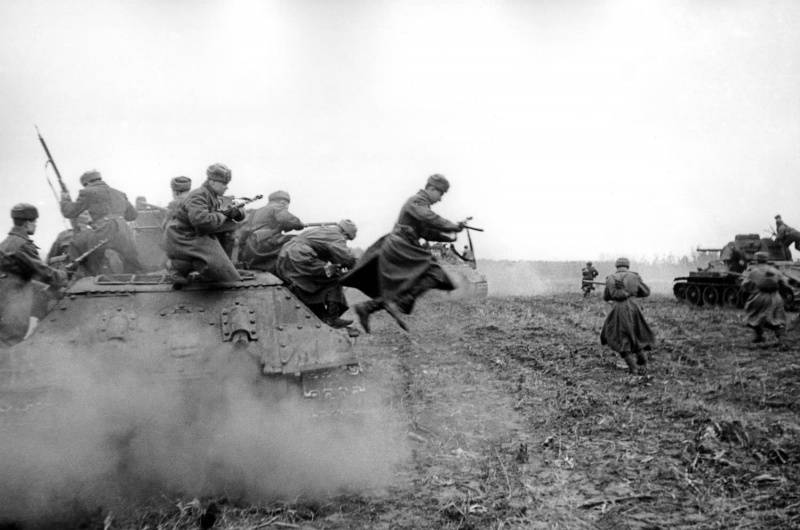
Soviet T-34 tanks with assault rifles engage in battle on the outskirts of Budapest. 1944
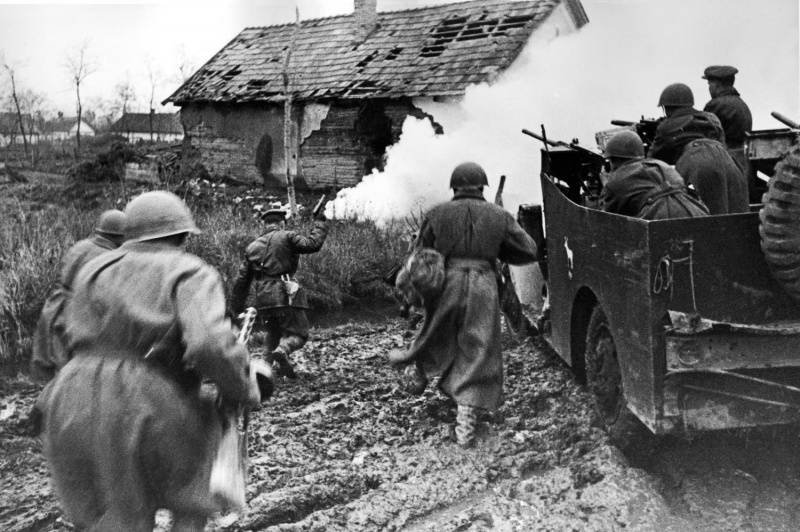
Soviet soldiers with an M3A1 Scout Car (American-made Lend-Lease-manufactured) reconnaissance armored personnel carrier in battle for a settlement near Budapest. 1945
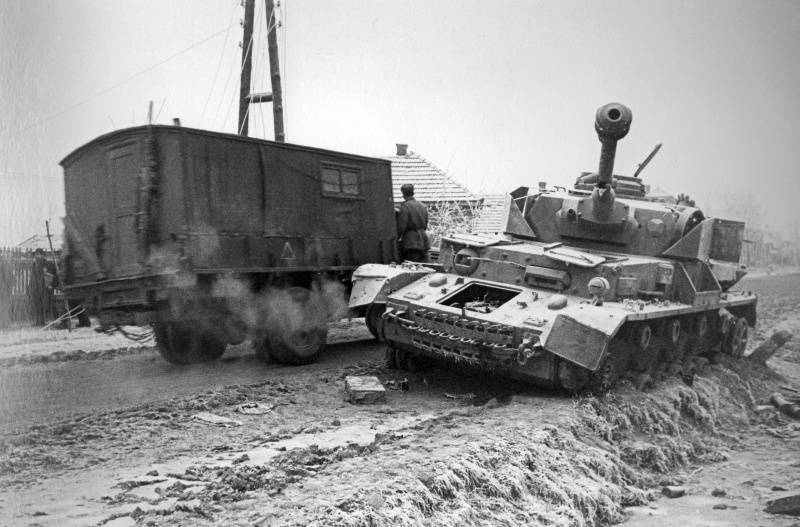
The Soviet Ford truck (Ford G8T, American-made) drives past the German Pz.Kpfw tank. IV, shot down under Budapest. 1945
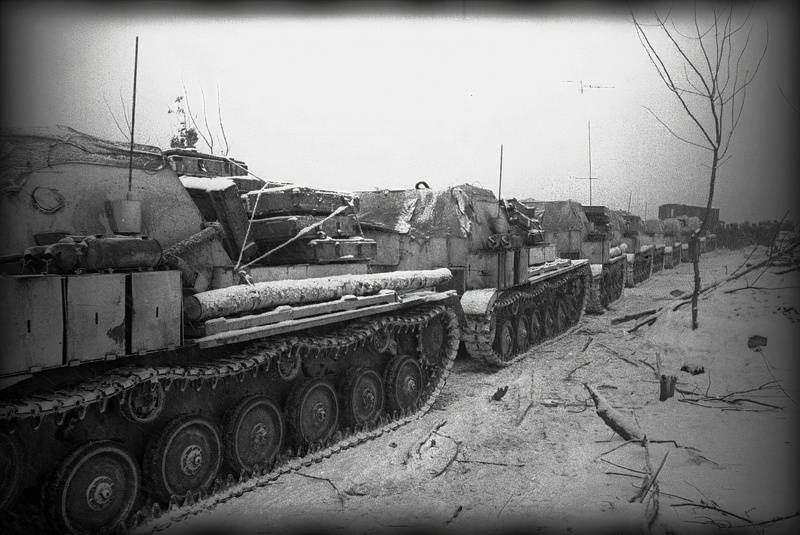
A column of Soviet self-propelled guns SU-76M before the march. It is assumed that the picture was taken during the Budapest operation
Budapest operation
On October 29, 1944, the troops of the left wing of the 2nd UV began the Budapest operation. The main blow was inflicted by units of the 46th Army, the 2nd and 4th Guards Mechanized Corps. Here mainly the Hungarian units defended themselves and the defense was weaker. Soviet troops had to go to the city from the southeast and take it on the move. From the northeast, an auxiliary strike was delivered by the 7th Guards Army. The rest of Malinovsky’s troops advanced in the direction of Miskolc. The troops of the 3rd UV (3rd UV) under the leadership of Tolbukhin had just completed the Belgrade operation and began to transfer to Hungary the 57th army, which was concentrated in the Banat area and was supposed to capture the bridgeheads on the Danube.
The left wing of the 2nd UV broke through the enemy’s defenses and by November 2, 1944, our troops reached the approaches to Budapest. However, on the move to take the Hungarian capital failed. The German command transferred 14 divisions here (including three panzer and one motorized division from the Miskolc region), which, relying on a pre-prepared defense system, stopped the further advance of the Soviet troops. The Soviet Headquarters ordered to expand the offensive zone in order to defeat the Budapest group by strikes from the north, east and south. During November 1944, the Soviet armies broke through the enemy’s defenses between the Tissa and Danube rivers and, having advanced up to 100 km, reached the outer defensive contour of Budapest from the south and southeast. Meanwhile, troops of the 3rd UV captured a large bridgehead on the west bank of the Danube. After that, the troops of the center and the left wing of the 2nd UV received the task of creating an encirclement ring around Budapest.
On December 5–9, the troops of the 7th Guards, 6th Guards Tank Armies and the horse-mechanized group of Lieutenant General Pliev intercepted the northern communications of the Wehrmacht Budapest group. On the left wing of the 46th army crossed the Danube south of Budapest. But immediately from the west it was not possible to get around the city. Fierce fighting continued until December 26th. The Soviet command had to throw new powerful formations into battle: the 2nd Guards, 7th Mechanized and 18th Panzer Corps. Only in the 26th troops of the 2nd and 3rd UV united in the area of Esztergom and surrounded almost 190 thousand. enemy grouping.
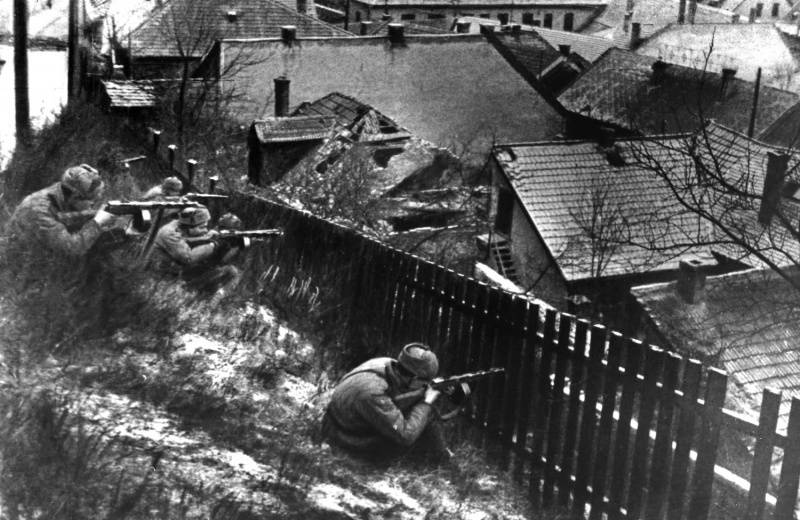
Submachine gunners of the 3rd Ukrainian Front are fighting on the street of Budapest. 1945
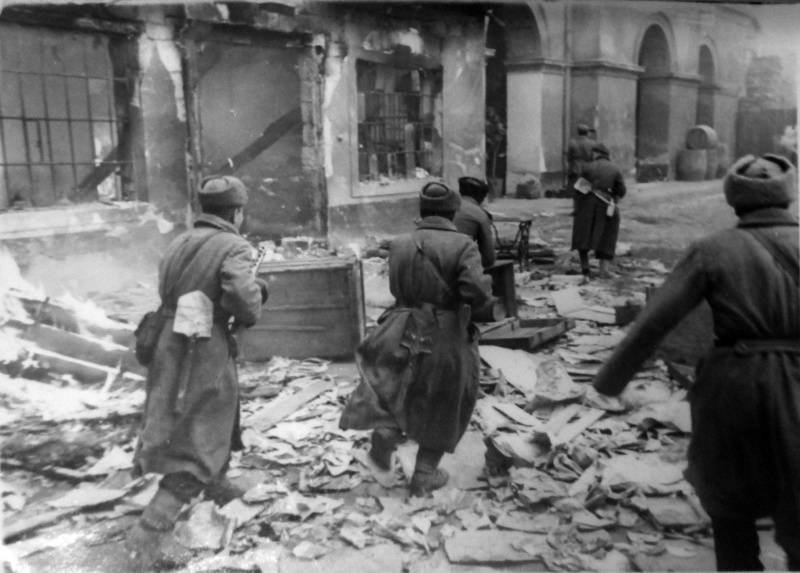
The assault group of the platoon commander of the 60th separate assault engineering and combat engineer battalion of the 12th assault engineering and combat brigade of the Third State Front RGC 3rd Lieutenant Yakov Stepanovich Gorynin in a street battle in Budapest. January 1945
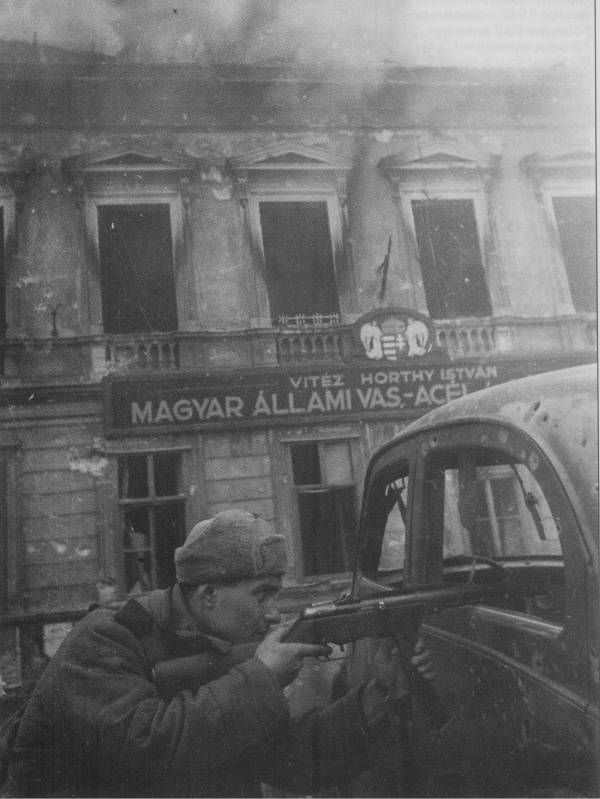
Soviet soldier in a street battle on Ferenc Square in Budapest. February 1945
Storming Budapest
It is worth noting that the German and Hungarian military commanders believed that Budapest should not be defended in conditions of complete encirclement. The Commander-in-Chief of Army Group South Johannes Friesner wanted to level the front line and avoid street fighting. He also noted the strong anti-German sentiment of the inhabitants of the capital. In the rear of the German troops a riot could break out. The commander of the 6th German Army, General Maximilian Fretter-Picot, wanted to retreat behind the Attila Line in order to avoid the threat of encirclement. The Hungarian command also considered the defense of Budapest possible only in the defense zone of the Attila Line. The capital, after breaking through the defensive line and the threat of the environment, was not going to defend. The "national leader" of the Hungarian state of Salashi also feared the uprising of the "rabble of the big city" and believed that troops should be withdrawn to the mountainous regions. The Hungarian leadership proposed declaring Budapest an “open city” and thereby avoiding the destruction of the historic capital.
Hitler did not take into account the arguments of his command and the Hungarian military-political leadership. The troops did not withdraw. The Führer ordered to defend every house, not to take into account losses and by an order of December 1, 1944 declared Budapest a fortress. The commandant of the city appointed the top leader of the SS and the police in Hungary, the general of the SS troops, Obergruppenführer Otto Winkelmann. The 9th SS Mountain Corps under the command of the SS Obergruppenführer Karl Pfeffer-Wildenbruch was handed over to him. In fact, it was he who became the leader of the defense of Budapest. Each stone house became a small fortress, streets and quarters - bastions. For their defense they mobilized all they could. Frisner and Fretter-Picot removed from their posts. Army Group "South" was led by Otto Veller, and the 6th Army - Balck.
After the encirclement there was the possibility of withdrawing a combat-ready core from Budapest. At first, there was no tight circle of encirclement, and the German-Hungarian troops, especially with external support, could break through to their own. But they did not receive such an order. On the contrary, they were instructed from above to stand to the last. As a result, Budapest, with its more than one million people, became the scene of a fierce battle, the “Danube Stalingrad”, due to the fault of the Führer. To capture the city, a Budapest group was formed under the command of General I.M. Afonin (then I.M. Managarov). It consisted of 3 rifle corps and 9 artillery brigades.
The siege of Budapest was delayed due to the heavy fighting that continued in Hungary. The German High Command continued to build up the forces of Army Group U in Hungary. 37 divisions were sent here, sent from other sectors of the front (including the central Berlin direction) and from the Western Front. By the beginning of January 1945, the Germans had concentrated 16 armored and motorized divisions here — half of all the Reich’s armored forces on the Russian front. In January 1945, the Nazis struck three powerful blows with the goal of releasing the Budapest group and leveling the front along the Danube (Operation Konrad).
Interestingly, Hitler did not want to cut through the corridor to Budapest with the goal of withdrawing the garrison there, on the contrary, but he wanted to strengthen it with fresh forces. In his opinion, the “Danube Stalingrad” was to grind the Russian troops and tie them together. It was necessary to keep the western part of Hungary and cover the way to Vienna. Therefore, the Führer categorically rejected any idea of surrendering Budapest and breaking through its garrison towards its own. The Budapest garrison was to keep the city until the arrival of its troops. Therefore, the Pfeffer-Wildenbruch group did not attempt to leave their city towards releasing forces and until the last waited for release. As a result, Hungary became a field of extremely stubborn and fierce battle. So on January 18 - 26, the Germans struck from the area north of Lake Balaton, dismembered the front of the 3rd UV and reached the Danube. The enemy’s breakthrough was eliminated only by the joint efforts of the troops of the 2nd and 3rd UV.
Meanwhile, the forces of the 2nd UV continued the fierce battle for the Hungarian capital. They tried to cut through the enemy’s defenses, and then destroyed separate, isolated enemy garrisons. The tactics of assault groups were actively used. Such a group usually included a platoon of riflemen, sappers, flamethrowers, it was supported by 1-2 tanks or self-propelled guns, guns that were hit by direct fire. On January 18, 1945, our troops took the eastern part of the city - Pest, and on February 13 - the western - Buda. The rest of the German-Hungarian group tried to break out of the city as early as February 11, since the integral defense collapsed and it was necessary to break through or surrender, and the Nazis did not want to surrender. The fighting lasted a few more days. Only a few hundred soldiers and officers were able to leave. The rest were killed or captured. The final cleaning of the city was completed by February 17. Over 138 thousand people were taken prisoner together with the command.
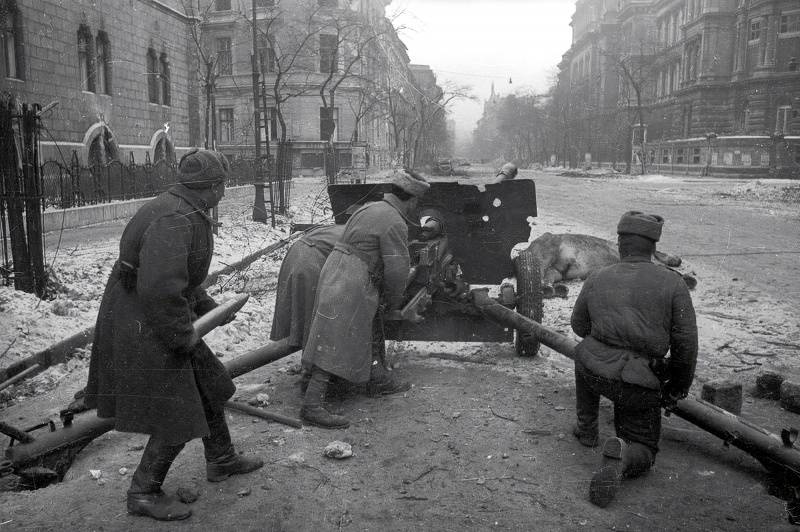
The calculation of the Soviet 76-mm gun ZiS-3 is firing on the street of Budapest. January-February 1945
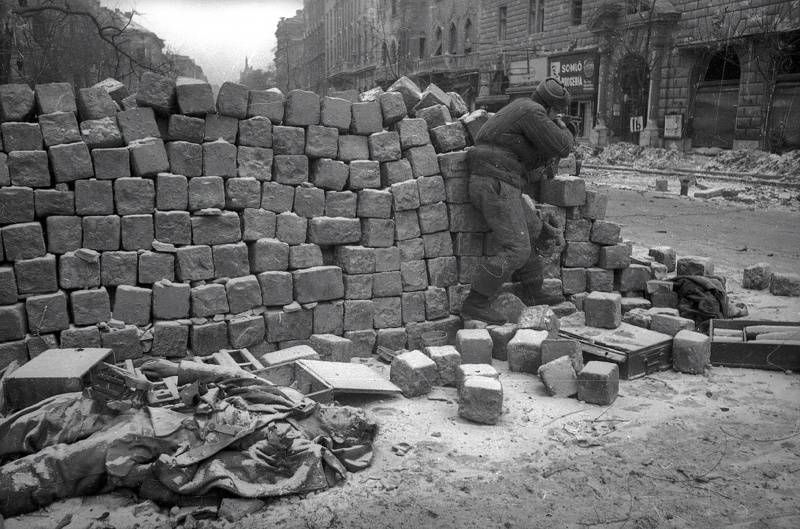
Soviet submachine gunner at the barricade on Kalwaria Square in Budapest. Under the barricade, made of pavers, lies the corpse of a German soldier. February 1945
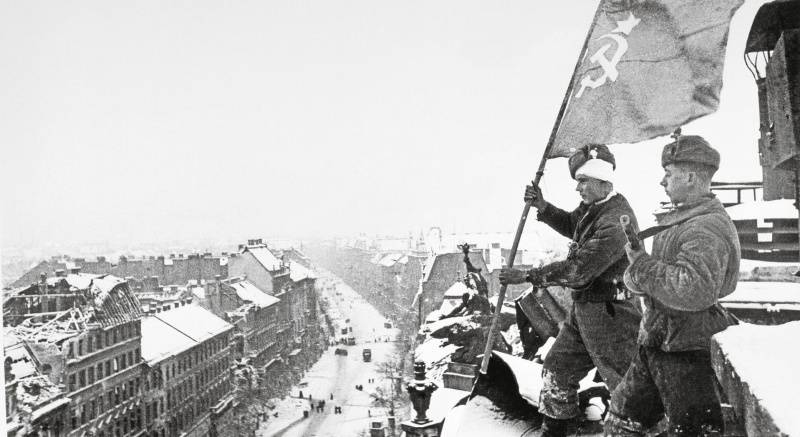
Senior sergeant Yevgeny Ivanovich Kosterev and junior sergeant Alexander Dmitrievich Pertyakov from the 1405th anti-aircraft artillery regiment of the 38th anti-aircraft artillery Cherkasy Red Banner Division of the High Command Reserve set the Soviet flag over Budapest. Photo taken on the roof of New York Palace
Results of the operation
Soviet troops liberated the central part of Hungary and Budapest from the Nazis and their local accomplices. The Budapest enemy group was defeated. Hungary withdrawn from the war. The interim government of Hungary on December 28, 1944 decided to withdraw from the war and declared war on the Reich. On January 20, 1945, the Provisional Government entered into a truce with the powers of the anti-Hitler coalition. The Salashi government continued to resist. Hungarian troops fought on the side of the Germans in the Balaton operation and in Austria.
The battle in Hungary, including the Budapest direction, attracted significant Wehrmacht forces, including from the central (Berlin) direction. The battle for Budapest facilitated the Red Army conducting the Wisla-Oder operation, a breakthrough to Berlin.
The defeat of the Budapest enemy grouping seriously changed the situation on the southern wing of the Soviet-German front. A threat was created to the communications of the Balkan group of the Wehrmacht, its withdrawal was accelerated. The Red Army got the opportunity to develop an offensive in Czechoslovakia and Austria.
The Budapest operation is described in more detail in the articles on “VO”: Battle for hungary; The beginning of the siege of Budapest; Breakthrough "Attila Line". The beginning of the Pest assault; Fall Pest. The beginning of the storming of Buda; Strong assault on Buda; Operation "Conrad"; The bloody finale of the Budapest group.
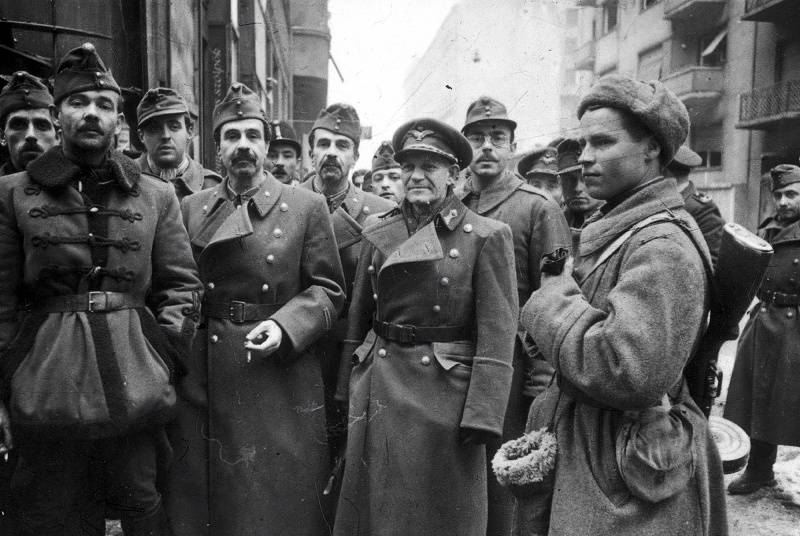
A soldier with a group of captured Hungarian soldiers and officers on the Kinizi street in Budapest. February 1945
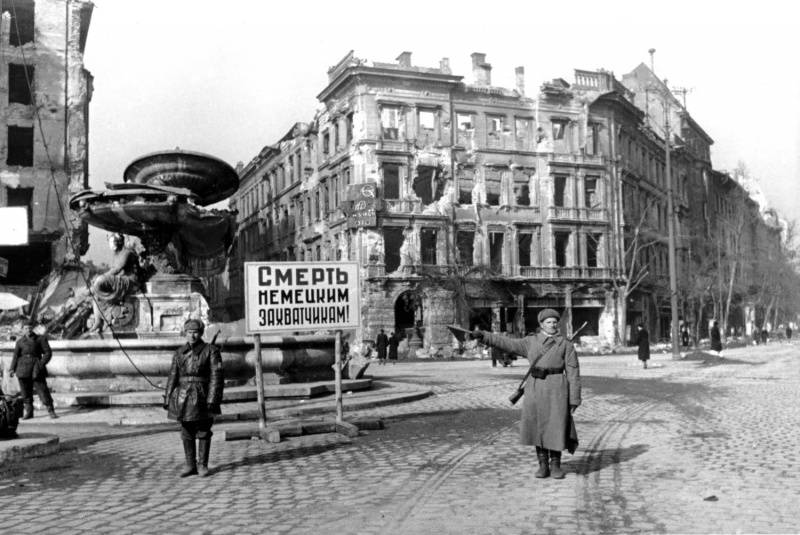
Soviet traffic controller at the poster "Death to the German invaders!" On Calvin Square (Erzhebet Square) in Budapest. In the center is the Danubius Fountain (Danube Fountain). February 1945
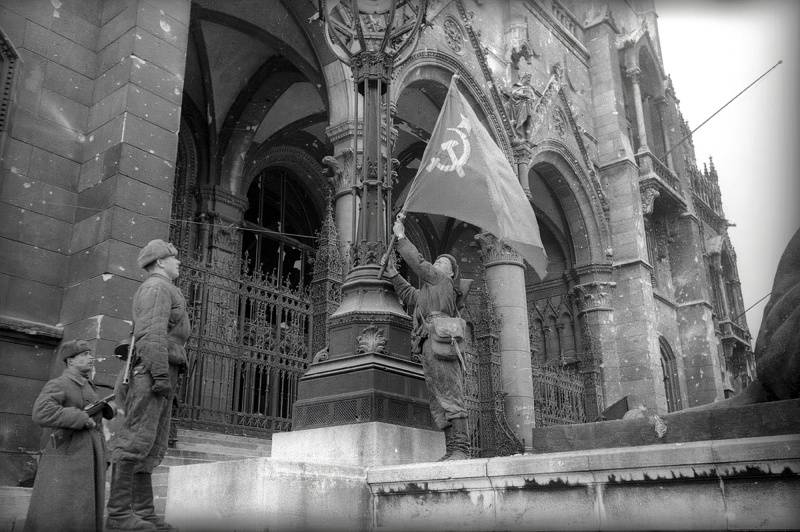
Soviet machine gunners hoisted a red banner at the entrance to the Hungarian parliament in Budapest. February 1945
- Alexander Samsonov
- http://waralbum.ru/
- The agony of the Third Reich
The Agony of the Third Reich. 75 years of the Vistula-Oder operation
The assault on the East Prussian fortress of the Reich
How Soviet troops liberated Warsaw
How Stalin created the foundations of a new world
The fierce battle for the Slavic Pomerania
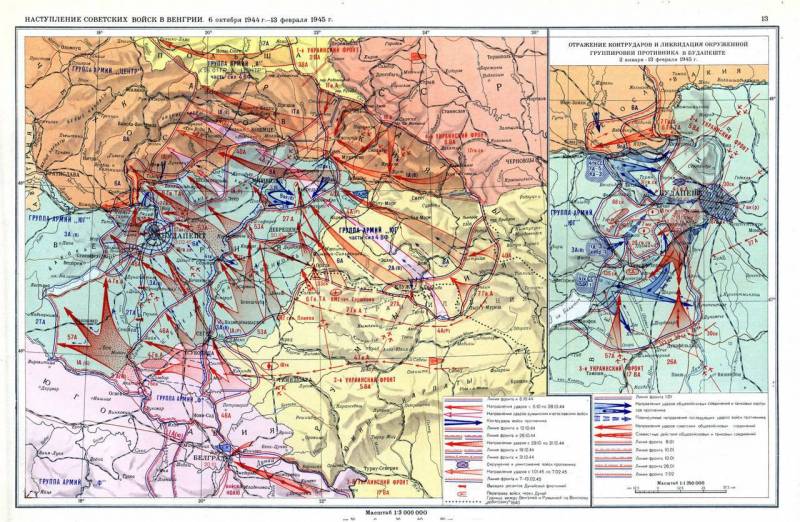
Information